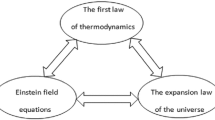Summary
We further explore new physical implications related to many-particle systems, thermodynamics and the cosmic 3 K radiation within the framework of common relativity which allows natural introduction of additional concepts that are not possible in special relativity. We employ an invariant genergyG=p 0/C to define the invariant partition functionZ and formulate covariant thermodynamics based on common relativity. Invariant Planck distribution for the black-body radiation is obtained. According to common relativity, the observed anisotropy of the 3 K radiation is not related to the angular dependence of the Planck distribution due to the absolute motion of the Earth in the cosmic black-body radiation because the spectral distribution of the «radiation energy» is covariant. This is in sharp contrast with the usual interpretation based on special relativity, in which the spectral distribution of the radiation energy is not covariant and has the simplest form in a particular reference frame.
Riassunto
Si indagano ulteriormente nuove implicazioni fisiche in relazione a sistemi a molte particelle, alla termodinamica e alla radiazione cosmica a 3 K nell’ambito della relatività comune che permette la naturale introduzione di concetti addizionali che non sono possibili nella relatività speciale. S’impiega un’energia invarianteG=p 0/C per definire la funzione di partizione invarianteZ e formulare la termodinamica covariante basata sulla relatività comune. Si ottiene la distribuzione di Planck invariante per la radiazione del corpo nero. Secondo la relatività comune, l’anisotropia osservata della radiazione a 3 K non è in relazione con la dipendenza angolare della distribuzione di Planck dovuto al movimento assoluto della Terra nella radiazione cosmica da corpo nero perché la distribuzione spettrale dell’ «energia di radiazione» è covariante. Ciò è in acuto contrasto con la solita interpretazione basata sulla relatività speciale, nella quale la distribuzione spettrale dell’energia di radiazione non è covariante ed ha la forma piú semplice in un particolare sistema di riferimento.
Резюме
Анализируются новые физические следствия, связанные с многочастичными системами, термодинамикой и космическим излучением при 3 К, в рамках общей теории относительности, которая позволяет естественным образом ввести дополнительные концепции, которые невозможны в рамках специальной теории относительности. Мы используем инрариантную энергиюG=p 0/C, чтобы определить инвариантную функцию распределенияZ, и формулируем ковариантную термодинамику, основанную на общей теории относительности. Получается инвариантное распределение Планка для излучения черного тела. Согласно общей теории относительности, наблюденная анизотропия космеического излучения при 3 К не связана с угловой зависимостью распределения Планка, обусловленной абсолютным движением Земли в космическом излучении черного тела, потому что спектральное распределение «энергии излучения» является ковариантным. Этот результат противоречит обычной интерпретации, основанной на специальной теории относительности, в которой спектральное распределение энергии излучения не является ковариантным и имеет простейшую форму в выделенной системе отсчета.
Similar content being viewed by others
References
J. P. Hsu:Phys. Lett. A,97, 137 (1983);Nuovo Cimento B,74, 67 (1983);J. P. Hsu andT. N. Sherry:Found. Phys.,10, 57 (1980).
J. P. Hsu:Nuovo Cimento B,91, 218 (1986).
J. P. Hsu:Nuovo Cimento B,78, 85 (1983).
J. P. Hsu:Nuovo Cimento B,80, 183 (1984).
V. F. Weisskopf:Am. Sci.,71, 473 (1983);S. Weinberg:Gravitation and Cosmology: Principles and Applications of the General Theory of Relativity (Wiley, New York, N. Y., 1972), p. 506 and references therein.
R. Hakim:J. Math. Phys. (N. Y.),8, 1315 (1967).
L. Landau andE. Lifshitz:The Classical theory of Fields (Addison-Wesley Press Cambridge, Mass. 1951), p. 40.
V. Fock:The Theory of Space Time and Gravitation (Pergamon Press, London, 1958), p. 80.
Nature Editorial, Nature (London),303, 129 (1983).
J. P. Hsu:Nuovo Cimento B,80, 201 (1984).
C. Møller:The Theory of Relativity (Oxford University Press, London, 1962), p. 117.
Here we do not consider the modification due to the radical length. For a discussion of such a modification, seeJ. P. Hsu:Nuovo Cimento B,81, 153 (1984).
B. Touschek:Nuovo Cimento B,58, 295 (1968).
As one can see from (41), if one measures the wave-length of a wave directly, the Doppler effect is precisely the same as that in special relativity. The Doppler effect for the frequency or atomic-energy levels should be viewed on the basis of eqs. (42), (43) and (44) in common relativity. Thus the present theory can account for the features of the emission of light from galaxies and from rapidly moving atoms in laboratories. So far, it appears that no experiment can definitely test the transformation property of the Planck distribution by itself. For experiments of Doppler effects, see, for example,H. E. Ives andG. R. Stilwell:J. Am. Opt. Soc.,28, 215 (1938);31, 369 (1941);H. J. Hay, J. P. Schiffer, T. E. Cranshaw andP. A. Egelstaff:Phys. Rev Lett.,4, 165 (1960);J. J. Snyder andJ. L. Hall:Laser Spectroscopy, edited byS. Haroche et al. (Springer-Verlag, New York, N. Y., 1975), p. 6. For detailed discussions of Doppler effects, seeJ. P. Hsu:Found. Phys.,8, 371 (1978).
P. J. E. Peebles andD. T. Wilkinson:Phys. Rev.,174, 2168 (1968);G. F. Smoot, M. V. Gorenstein andR. A. Muller:Phys. Rev. Lett. 39, 898 (1977).
J. P. Hsu:Nuovo Cimento B,75, 185; (1983);J. P. Hsu andT. Y. Shi:Phys. Rev. D,26, 2745 (1982).
Author information
Authors and Affiliations
Additional information
Traduzione a cura della Redazione.
Переведено редакцией.
Rights and permissions
About this article
Cite this article
Hsu, J.P. Covariant thermodynamics and questions on Earth’s absolute motion in the 3K radiation. Nuov Cim B 93, 178–194 (1986). https://doi.org/10.1007/BF02722329
Received:
Published:
Issue Date:
DOI: https://doi.org/10.1007/BF02722329



